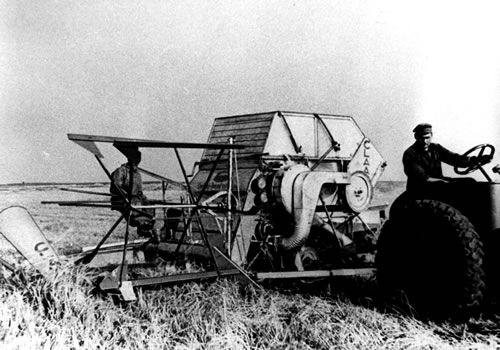
At this year’s Cereals event, CLAAS UK will be celebrating the 75th anniversary of the development of the first European combine harvester.
Few people watching machine number 1 starting to harvest its first crop at Zschernitz Manor near Halle in Germany in 1936 could have foreseen the impact that the combine harvester would have on arable farming and world food production.
It would have been impossible to imagine at that time the advances that would be made in agricultural machinery development. Today the flagship CLAAS LEXION 770, steered by satellite, controlled by computers and cutting 12 metres in a single pass at a rate of up to 100 tonnes an hour, can clear in just 20 minutes what it took that first machine all day to cut.
The past 75 years have seen the ongoing development of the combine harvester enabling growers to fully benefit from the simultaneous breeding of higher yielding, improved quality cereal varieties, and at the same time helping farmers to reduce production cost and meet the needs of an expanding world population.
The development of the first European built combine harvester by August CLAAS, evolved after the arrival of a number of American built, tractor drawn harvesting machines that were trialled in Europe during the late 1920’s.
However, designed for the thinner crops of the American Mid-West, it was quickly apparent that these machines could not cope with European crops and conditions.
Inspired by these early trials, August Claas set about designing a machine that would be better suited to European conditions, and by the early 1930s had developed a prototype harvester built around a Lanz Bulldog tractor that used a front-mounted cutterbar.
This early machine was, however, ahead of its time and met with some scepticism. Undaunted August Claas went back to the drawing board and in 1936 unveiled a new machine, the MDB, which featured a side-mounted cutterbar and was capable of harvesting 30 tonnes of wheat a day. Although still met with some scepticism, August Claas went ahead with production and by 1942 over 1,400 had been manufactured at Harsewinkel.
Following the end of the 2nd World War, production started in 1946 of a new trailed harvester, the ’SUPER’, which went on to be sold around the world and only ceased production in 1972, by which time more than 65,000 had been sold.
The first self-propelled combine, the ’HERCULES’, was launched by CLAAS in 1953 and was to be the start of a succession of highly successful combines, including in 1970 the introduction of the DOMINATOR, which is still in production today and has been one of the most successful combine harvesters in the world.
/...
-2-
CLAAS has led the way in the development of many revolutionary features and remains the undisputed market leader in Europe. The cross-axial flow threshing system, tracks, the VARIO cutterbar, APS primary threshing system and the CEBIS control system have all contributed to the success of the CLAAS combine with one in every three combine harvesters sold in Europe being manufactured at Harsewinkel.
CLAAS are currently celebrating their 75 years anniversary of combines and in recognition of this major milestone, are inviting users from around the world to tell them about their experiences and to send in any historic photographs and film that they may have.
These can be viewed on a web special that has been set-up at www.mycombine.claas.com. A selection of stories from around the world will be published in a special edition hardback book, to be available for sale at the Agritechnica Show in Hannover in November of this year.
75 years of CLAAS combine development:
1936-1946 MDB
1946-1972 SUPER
1953-1963 HERCULES
1953-1972 JUNIOR
1956-1960 HUCKEPACK
1958-1968 EUROPA
1959-1970 COLOMBUS
1961-1969 MATADOR
1962-1968 MERCUR
1966-1972 SENATOR (the first in CLAAS green)
1967-1970 GARANT
1967-1981 CONSUL
1967-1982 MERCATOR
1968-1970 COMET
1968-1971 COSMOS
1968-1981 PROTECTOR
1969-1974 CORSAR
1970-1981 COMPACT
1970-today DOMINATOR
1981-1995 COMMANDOR CS
1993-2009 MEGA
1995-2004 LEXION 400
2000-2009 MEDION
2003-2010 LEXION 500
2005-2010 LEXION 600
2007-today TUCANO
2009-today AVERO
2010-today LEXION 600
2010-today LEXION 700
